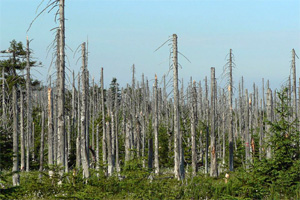Cloud Physics Research - Background
Why Study Clouds?
Clouds are significant in the atmosphere for a number of reasons: they are an important component of the earth’s climate and are crucial when considering climate change; they are responsible for much of the weather we experience; and they are influential in the transport and deposition of airborne particles and pollution. Our understanding of these aspects of the earth – atmosphere system is in part dependant on our understanding of the detailed processes which take place in clouds. However these processes are complex, are different in different types of cloud and are sensitive to many external factors. In many cases, especially in mixed phase clouds (clouds containing both liquid water drops and ice crystals), these processes are not well understood hence the need for research into detailed cloud processes.
On this page the role of clouds in the earth atmosphere system is discussed in a little more detail. Other pages in this section briefly explain visual cloud classification, warm cloud processes, ice cloud processes and the influence of dynamics on cloud formation and development.
Clouds and Climate

Clouds have a very significant influence on the earth’s radiative balance and hence climate since they cover a very large area of the earth’s surface, and interact with both solar and terrestrial radiation. Cloud particles scatter solar radiation and are responsible for reflecting away about 26% of incoming solar radiation. This is over 70% of the total amount reflected and represents a cooling effect estimated at between -42 and -74 W m-2. Mid and low-level stratiform cloud is responsible for most of this cooling as these clouds have a much greater optical depth at solar wavelengths than high level cirrus clouds. Cloud over ocean areas is especially important due to the low albedo (reflectivity) of the ocean surface compared to the continents.
Clouds also interact with longwave radiation emitted from the surface of the earth, absorbing a significant fraction at some wavelengths. The absorption and emission mechanisms within clouds are different from those in gases, such that the amount of radiation emitted is dependant on the temperature of the cloud. Hence, temperature at cloud top determines the amount of radiation lost to space. Interaction of cloud with infra-red radiation produces a significant warming effect of between 22 and 55 W m-2, with high-level cirrus clouds thought to be especially important. The net effect of clouds on climate is a cooling, estimated to be 15 W m-2, although there is still some uncertainty surrounding this figure. Locally the net effect of clouds can range from a net warming, to much greater cooling than that quoted above.
When considering climate change the influence of clouds on climate is crucial, but much less well understood and quantified than that of greenhouse gases. Changes in global temperature may affect the location, extent and type of cloud, this change would in turn have a warming or cooling effect. This is known as a climate change feedback, such feedbacks may act to offset or amplify any changes due to greenhouse gas emissions. In order to assess the magnitude and direction of such feedbacks it is necessary to have a thorough understanding of cloud processes.
In addition to any feedback effects, the radiative properties of clouds are strongly influenced by their microphysical properties (properties of the individual cloud particles i.e. size, shape and number concentration). For example a cloud with a larger number of small particles reflects more solar radiation than a cloud with fewer large particles, both containing the same quantity of water. This is true for both water and ice clouds. Further in some cases smaller droplets suppresses the formation of precipitation leading to enhanced cloud lifetime and cloud cover. Anthropogenic emissions in addition to containing greenhouse gases also contain aerosol particles, or material which later leads to the formation of aerosol particles. It is well established that cloud droplet number concentration is strongly related to the number of soluble aerosol present. The larger the number of aerosol particles, the larger the number of cloud droplets number, the smaller their size, and the more reflective (and sometimes long lived) the cloud. This is known as the aerosol indirect effect on climate. At present the effect of aerosol particles on ice and mixed phase clouds is often not well understood.
Clouds and Weather
A significant proportion of precipitation is produced by ice and mixed phase clouds. Often whether a cloud becomes glaciated or not will determine the extent to which it develops and whether precipitation is produced. It is notoriously difficult to predict the location of convective storm systems, which can often result in significant rainfall and potentially severe local flooding. This difficulty is due in part to the fact that the processes governing the initiation and development of such systems are not well understood and are not well represented in operational forecast models.
An understanding of cloud processes is also needed to assess changes in weather patterns which may result from global warming. Attempts at weather modification (such as cloud seeding which was tried in certain parts of the USA) and proposed geoengineering projects to offset the effects of greenhouse gas emissions also rely on an understanding of cloud physics processes.
Clouds and Pollution
An understanding of clouds is important for an understanding of the processing and deposition of pollution in the atmosphere. Wet deposition is one of the main routes by which particulate matter and soluble gas phase species are removed from the atmosphere. A raindrop will remove from the atmosphere all the aerosol particles on which the cloud drops or ice crystals formed and any that have been captured during its lifetime in the atmosphere and fall to the surface. Soluble gas phase species generally exist in equilibrium with the aqueous phase in clouds and so are also removed especially if aqueous chemical processes result in the production of non volatile material from such species.
A major example of cloud processing and subsequent deposition of pollution is acid rain – responsible for damage to Scandinavian forests and lakes and upland areas of the United Kingdom and similar areas around industrialised areas worldwide. This is largely due to sulphur dioxide and oxides of nitrogen emissions from coal burning power stations, vehicles and other industrial sources, which are then processed in the atmosphere to produce sulphuric and nitric acid through both gas and aqueous phase reaction pathways. This acid is then deposited in rainfall causing the damage observed.
Even if a cloud does not result in precipitation aqueous chemistry may still take place resulting in the deposition of additional soluble material onto the existing aerosol, which often remains after the cloud evaporates, so redistributing material between gas and particle phases. Ice clouds may also be important for atmospheric chemistry as they provide a surface on which heterogeneous reactions may occur, but such processes are not well quantified.
As well as contributing to processing and deposition of material, cloud systems may also contribute to the vertical transport of material from the boundary layer into the upper troposphere and lower stratosphere, where such material can remain for an extended period of time. The strong updrafts which are found in deep convective storm systems rapidly transport air from the boundary layer to the tropopause. It is not clear however how much of that material remains there as the storm dissipates.
